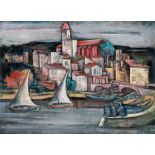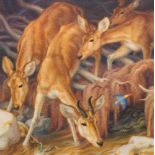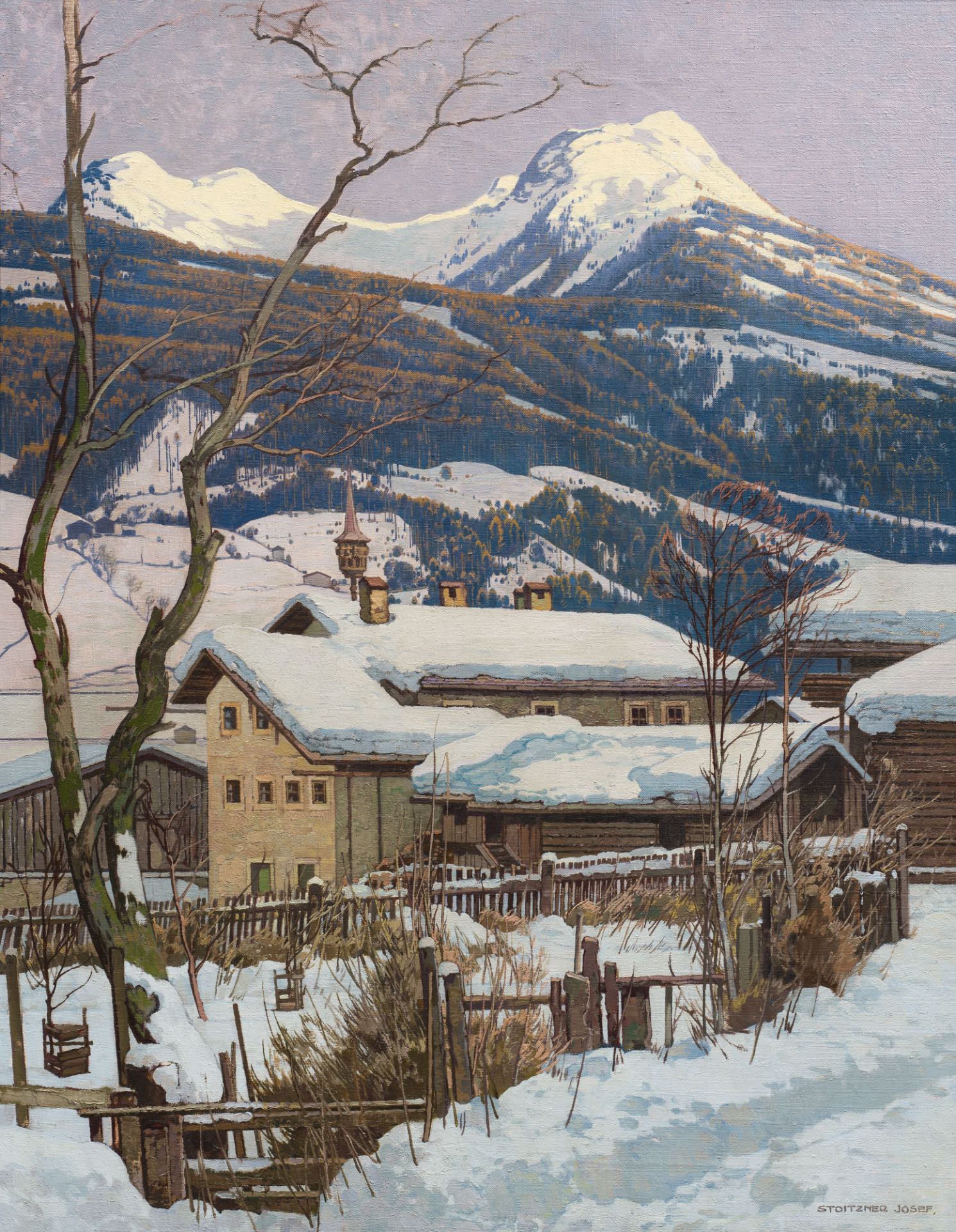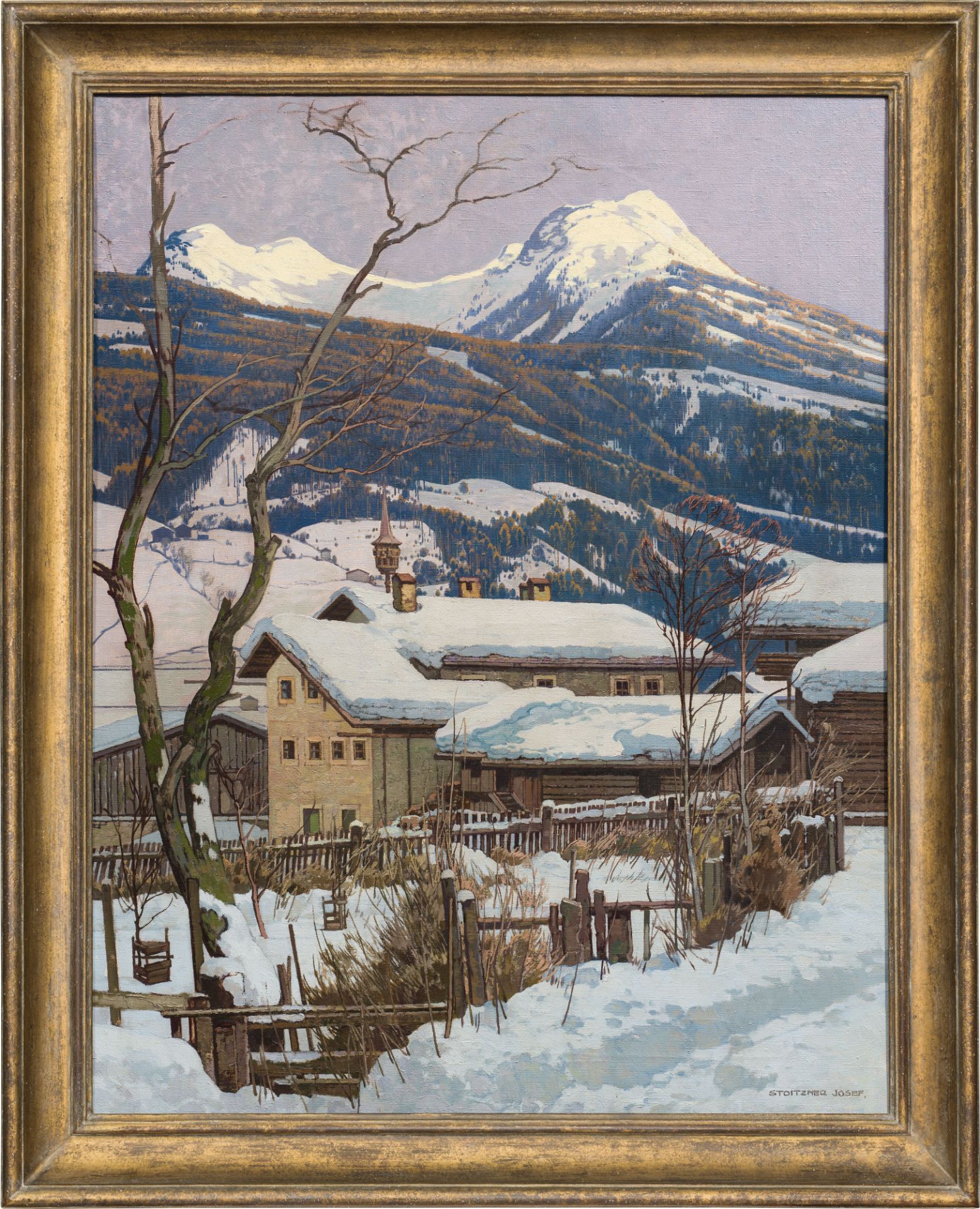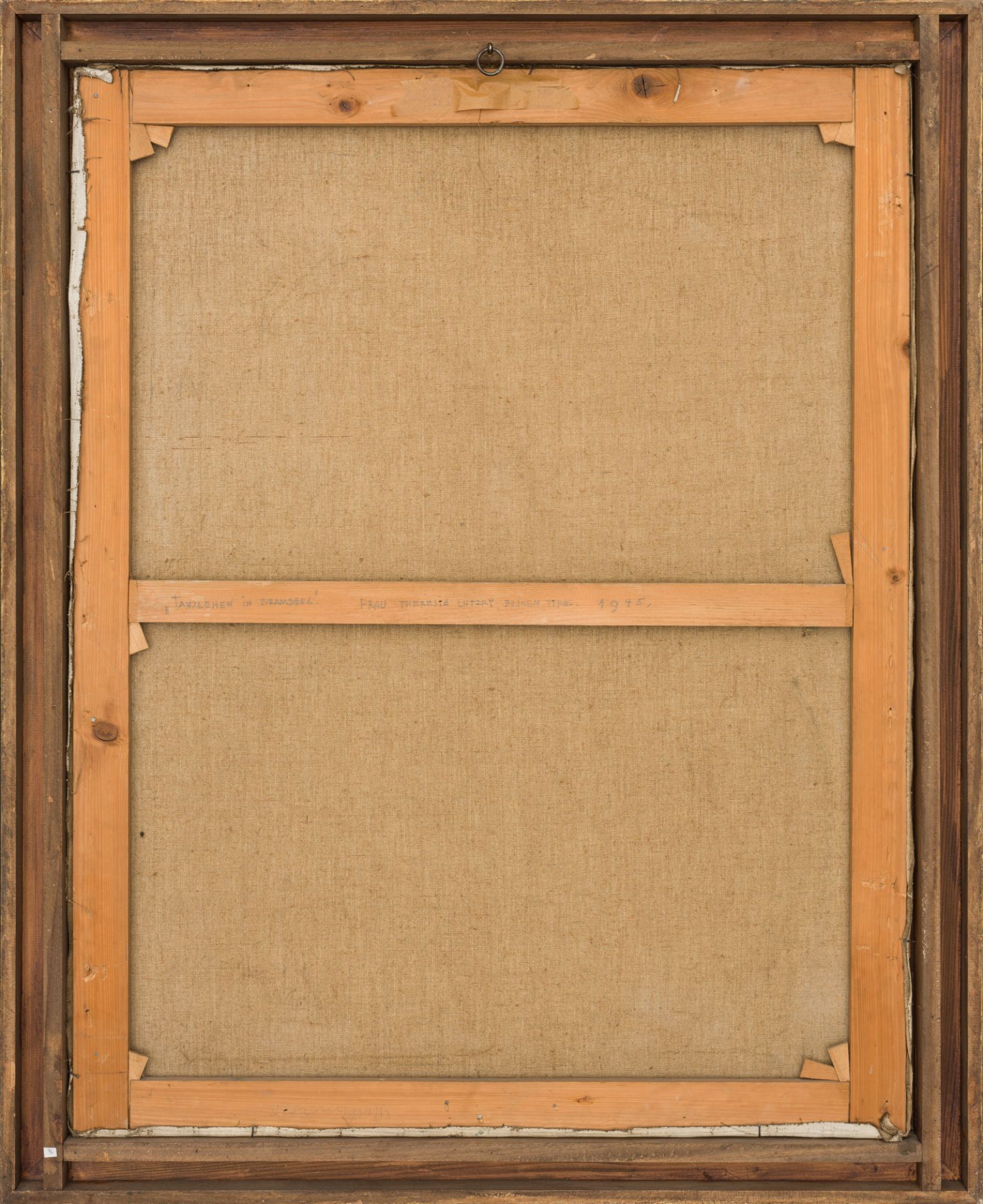22
Josef StoitznerTanzlehen in Brambergc. 1935oil on canvas; framed116 x 90 cmsigned on the lower
Josef Stoitzner
Tanzlehen in Bramberg
c. 1935
oil on canvas; framed
116 x 90 cm
signed on the lower right: Stoitzner Josef.
titled on the reverse on the stretcher: "Tanzlehen in Bramberg" and property note "Frau Theresia Lutzky, Brixen, Tirol, 1945"
private property, Austria
Kolhammer & Mahringer (ed.), Josef Stoitzner. Das Gesamtwerk, Vienna 2019, WVJS 1.6.95., ill. p. 495
Starting out from the design principles of Art Nouveau, between graphic stylisation and a special feel for picturesque, atmospheric images, Josef Stoitzner arrived at his personal, unique style of painting, characterised by a highly sophisticated, fine, detailed and precise touch. He did not aspire to capture a landscape in the moment, but instead always sought to depict the timeless beauty of nature. And the artist achieved this in a masterly manner.
In this painting, "Tanzlehen in Bramberg", the viewer is presented with a winter landscape with a sweeping view from a low-lying vantage point up to the snow-covered, majestic peaks of the mountains, which are bathed in a lovely, auspicious light by the sun. In the foreground are fences, small trees, a tall, bare tree on the left side of the picture, which adds to the sense of depth of the foreground and background, and village houses. The snow has added wintry adornment to the scene. Behind the village wooded, snow-covered slopes lead one’s gaze further, right up to the highest reaches of the towering mountains. With a penchant for the lyrical, he leaves the village scene and the rising hills in shadow, leaving only the peaks evocatively illuminated by the sun's rays. The high horizon has been skilfully positioned so as to support the viewer’s sweeping gaze and to emphasise the grandeur of the mountain formations. Both a realistic and a romanticised mode of expression are inherent to this masterly painting. Another characteristic feature is the stillness that lies over the deserted view. Josef Stoitzner deliberately decided to omit the narrative element of humans and animals in order to avoid distracting the viewer from the beauty of nature depicted here. This work exemplifies Stoitzner’s oeuvre and his special ability to convey an evocative mood, as well as his fine powers of observation for every detail, no matter how tiny. The successful artist’s landscape paintings were thus already in great demand during his lifetime and awakened a longing for unspoilt, beautiful nature, particularly among the urban middle classes.
(Sophie Höfer)
Josef Stoitzner
Tanzlehen in Bramberg
um 1935
Öl auf Leinwand; gerahmt
116 x 90 cm
Signiert rechts unten: Stoitzner Josef.
Rückseitig am Keilrahmen betitelt: "Tanzlehen in Bramberg" sowie mit Eigentumsvermerk "Frau Theresia Lutzky, Brixen, Tirol, 1945"
österreichischer Privatbesitz
Kolhammer & Mahringer (Hg.), Josef Stoitzner. Das Gesamtwerk, Wien 2019, WVJS 1.6.95., Abb. S. 495
Josef Stoitzner fand, ausgehend von den Gestaltungsprinzipien des Jugendstils, zwischen graphischer Stilisierung und einem besonderen Gespür für malerisch-atmosphärische Darstellungen zu seinem persönlichen, unverkennbaren Malstil, der sich durch eine höchst anspruchsvolle, feine, detailreiche und präzise Handschrift auszeichnet. Er erhob nicht den Anspruch eine Landschaft im Moment einzufangen, sondern wollte stets die zeitlose Schönheit der Natur darstellen. Und dies ist dem Künstler auf meisterliche Weise gelungen.
Im vorliegenden Gemälde "Tanzlehen in Bramberg" zeigt sich dem Betrachter eine Winterlandschaft mit weiter Sicht vom tief gelegenen Standpunkt hinauf zu den schneebedeckten, majestätischen Gipfeln der Berge, die von der Sonne in schönes, verheißendes Licht getaucht werden. Im Vordergrund befinden sich Zäune, Bäumchen, ein hochaufragender, kahler Baum an der linken Bildseite, der die Tiefenwirkung von Vorder- und Hintergrund zusätzlich unterstreicht und dörfliche Häuser. Der Schnee hat die Szene winterlich geschmückt. Hinter dem Dorf führen bewaldete Schneehänge den Blick weiter bis hinauf zu den höchsten Punkten der aufragenden Berge. Mit einem Hang zum Lyrischen belässt er die Dorfszene und die ansteigenden Hügel im Schatten, um nur die Gipfel stimmungsvoll von den Sonnenstrahlen beleuchten zu lassen. Der hoch angesetzte Horizont ist gekonnt gewählt, um den weiten Blick des Betrachters zu unterstützen und die Größe der Bergformationen hervorzuheben. Sowohl eine realistische als auch romantisierende Ausdrucksweise ist dem meisterlichen Bild zu Eigen. Charakteristisch ist außerdem die Stille, die sich über die menschenleere Ansicht legt. Josef Stoitzner hat sich bewusst gegen das erzählerische Element Mensch und Tier entschieden, um den Betrachter von der Schönheit der dargestellten Natur nicht abzulenken. Das vorliegende Werk steht beispielhaft für das Oeuvre Stoitzners und seine besondere Fähigkeit, eine stimmungsvolle Atmosphäre wiederzugeben sowie seine feine Beobachtungsgabe für jedes noch so kleine Detail. Die Landschaftsbilder des erfolgreichen Künstlers sind daher schon zu seinen Lebzeiten sehr gefragt und wecken, im Besonderen beim städtischen Bürgertum, die Sehnsucht nach der unberührten, schönen Natur.
(Sophie Höfer)
Josef Stoitzner
Tanzlehen in Bramberg
c. 1935
oil on canvas; framed
116 x 90 cm
signed on the lower right: Stoitzner Josef.
titled on the reverse on the stretcher: "Tanzlehen in Bramberg" and property note "Frau Theresia Lutzky, Brixen, Tirol, 1945"
private property, Austria
Kolhammer & Mahringer (ed.), Josef Stoitzner. Das Gesamtwerk, Vienna 2019, WVJS 1.6.95., ill. p. 495
Starting out from the design principles of Art Nouveau, between graphic stylisation and a special feel for picturesque, atmospheric images, Josef Stoitzner arrived at his personal, unique style of painting, characterised by a highly sophisticated, fine, detailed and precise touch. He did not aspire to capture a landscape in the moment, but instead always sought to depict the timeless beauty of nature. And the artist achieved this in a masterly manner.
In this painting, "Tanzlehen in Bramberg", the viewer is presented with a winter landscape with a sweeping view from a low-lying vantage point up to the snow-covered, majestic peaks of the mountains, which are bathed in a lovely, auspicious light by the sun. In the foreground are fences, small trees, a tall, bare tree on the left side of the picture, which adds to the sense of depth of the foreground and background, and village houses. The snow has added wintry adornment to the scene. Behind the village wooded, snow-covered slopes lead one’s gaze further, right up to the highest reaches of the towering mountains. With a penchant for the lyrical, he leaves the village scene and the rising hills in shadow, leaving only the peaks evocatively illuminated by the sun's rays. The high horizon has been skilfully positioned so as to support the viewer’s sweeping gaze and to emphasise the grandeur of the mountain formations. Both a realistic and a romanticised mode of expression are inherent to this masterly painting. Another characteristic feature is the stillness that lies over the deserted view. Josef Stoitzner deliberately decided to omit the narrative element of humans and animals in order to avoid distracting the viewer from the beauty of nature depicted here. This work exemplifies Stoitzner’s oeuvre and his special ability to convey an evocative mood, as well as his fine powers of observation for every detail, no matter how tiny. The successful artist’s landscape paintings were thus already in great demand during his lifetime and awakened a longing for unspoilt, beautiful nature, particularly among the urban middle classes.
(Sophie Höfer)
Josef Stoitzner
Tanzlehen in Bramberg
um 1935
Öl auf Leinwand; gerahmt
116 x 90 cm
Signiert rechts unten: Stoitzner Josef.
Rückseitig am Keilrahmen betitelt: "Tanzlehen in Bramberg" sowie mit Eigentumsvermerk "Frau Theresia Lutzky, Brixen, Tirol, 1945"
österreichischer Privatbesitz
Kolhammer & Mahringer (Hg.), Josef Stoitzner. Das Gesamtwerk, Wien 2019, WVJS 1.6.95., Abb. S. 495
Josef Stoitzner fand, ausgehend von den Gestaltungsprinzipien des Jugendstils, zwischen graphischer Stilisierung und einem besonderen Gespür für malerisch-atmosphärische Darstellungen zu seinem persönlichen, unverkennbaren Malstil, der sich durch eine höchst anspruchsvolle, feine, detailreiche und präzise Handschrift auszeichnet. Er erhob nicht den Anspruch eine Landschaft im Moment einzufangen, sondern wollte stets die zeitlose Schönheit der Natur darstellen. Und dies ist dem Künstler auf meisterliche Weise gelungen.
Im vorliegenden Gemälde "Tanzlehen in Bramberg" zeigt sich dem Betrachter eine Winterlandschaft mit weiter Sicht vom tief gelegenen Standpunkt hinauf zu den schneebedeckten, majestätischen Gipfeln der Berge, die von der Sonne in schönes, verheißendes Licht getaucht werden. Im Vordergrund befinden sich Zäune, Bäumchen, ein hochaufragender, kahler Baum an der linken Bildseite, der die Tiefenwirkung von Vorder- und Hintergrund zusätzlich unterstreicht und dörfliche Häuser. Der Schnee hat die Szene winterlich geschmückt. Hinter dem Dorf führen bewaldete Schneehänge den Blick weiter bis hinauf zu den höchsten Punkten der aufragenden Berge. Mit einem Hang zum Lyrischen belässt er die Dorfszene und die ansteigenden Hügel im Schatten, um nur die Gipfel stimmungsvoll von den Sonnenstrahlen beleuchten zu lassen. Der hoch angesetzte Horizont ist gekonnt gewählt, um den weiten Blick des Betrachters zu unterstützen und die Größe der Bergformationen hervorzuheben. Sowohl eine realistische als auch romantisierende Ausdrucksweise ist dem meisterlichen Bild zu Eigen. Charakteristisch ist außerdem die Stille, die sich über die menschenleere Ansicht legt. Josef Stoitzner hat sich bewusst gegen das erzählerische Element Mensch und Tier entschieden, um den Betrachter von der Schönheit der dargestellten Natur nicht abzulenken. Das vorliegende Werk steht beispielhaft für das Oeuvre Stoitzners und seine besondere Fähigkeit, eine stimmungsvolle Atmosphäre wiederzugeben sowie seine feine Beobachtungsgabe für jedes noch so kleine Detail. Die Landschaftsbilder des erfolgreichen Künstlers sind daher schon zu seinen Lebzeiten sehr gefragt und wecken, im Besonderen beim städtischen Bürgertum, die Sehnsucht nach der unberührten, schönen Natur.
(Sophie Höfer)
Big Jubilee Auction: Evening Sale
Sale Date(s)
Venue Address
General delivery information available from the auctioneer
If you do not wish to collect your pieces from us yourself, we will arrange delivery for you. Our specialist business partners are professionals in packing, insurance and delivery and will provide these services at advantageous rates. The after-sales service usually proceeds as follows:If you would like, after the auction our logistics department will give you a quotation for transport and insurance.
If you would like to take advantage of this delivery option, contact the logistics department, after you have paid the purchase price, T +43 1 5324200-18 or r.mayr@imkinsky.com
When you place your order, your details will be sent to the appropriate shipping company. You will be contacted by our business partner to arrange a delivery date.
The price for transport and insurance is arranged directly with the shipping company.
If you don’t want to take advantage of this service, we must ask you to arrange collection yourself. We ask for your understanding that in this case we can take no responsibility for the quality of packing or transportation and can therefore take no responsibility for whether your pieces arrive intact.
Important Information
Exhibition 17-30 November
Mon-Fri 10am-6pm
Sat & Sun 10am-5pm
Terms & Conditions
Conditions of Auction
Extract from the rules of procedure
The wording of the complete rules of procedure can be viewed on our homepage www.imkinsky.com. By request we will also send the rules of procedure to you.
• Rules of Business: Auctions are conducted according to the conditions of sale as set down by Auktionshaus im Kinsky GmbH. The rules of business are available for viewing at the Auction House, and can be requested by post or email (office@imkinsky.com), they can also be called up on the internet under www.imkinsky.com.
• Estimates: In the catalogues the lower and upper estimated values are indicated and represent the approximate bid expectations of the responsible experts.
• Reserves (Limits): Sellers quite often appoint the auction house, not to sell their objects beneath certain price. These prices (= reserve/limit) usually match the lower estimate, but in special situations can also surpass them.
• Guarantee of Authenticity: The valuation, as well as technical classification and description of the art objects is carried out by the specialists of Auktionshaus im Kinsky. Auktionshaus im Kinsky guarantees the purchaser the authenticity for three years – i.e. that the authorship of the art object is as set out in the catalogue.
• Catalogue Descriptions: Catalogue information concerning techniques, signatures, materials, condition, provenance, period of origin or manufacture etc. are based on the current knowledge determined by the experts. Auktionshaus im Kinsky cannot be held responsible for the verification of these descriptions.
• Insurance: All the art objects are insured. The insurance value is the purchase price. The responsibility of the Auction House lasts until the eighth day after the auction. After that, each art object is only insured if there is an order from the purchaser to do so.
• Starting price & Hammer price: The starting price is determined by the auctioneer. The bidding rises in approximate increments of 10 % from the starting price, or from the last bid. The highest bidder acknowledged by the auctioneer will be the purchaser as long as it has reached the minimum price (reserve).
• Buyer’s Premium: For art objects which require ‘difference’ taxation the purchase price consists of the hammer price plus the sales commission of 26 %. For art objects which require ‘normal’ taxation (marked with ▲), the price consists of the hammer price plus commission of 22 %, plus VAT (13 % for paintings, 20 % for antiques). For hammer price in excess of € 300,000 we will charge a commission of 17 % (margin taxation) or 14 % (normal taxation).
• Droit de suite: Objects marked with an asterisk* in the catalogue are subject to droit de suite in addition to the purchase price. Droit de suite is calculated as a percentage of the highest bid as follows: 4 % of the first € 50,000, 3 % of the next € 150,000, 1 % of the next € 150,000, 0.5 % of the next € 150,000 and 0.25 % of the remaining amount (i.e. over € 500,000), but not exceeding a total sum of € 12,500. Droit de suite does not apply to highest bids below € 2,500.
• Absentee bids: Clients can also submit written absentee bids or bid themselves over the phone, or give an order to the broker. To do so Auktionshaus im Kinsky must have received signed order forms, (available in the catalogues), in due time.
• Telephone bids: We will do our best to establish a telephone link, but we cannot warrant for such a telephone connection.
• Online Bidding: Interested parties can participate in the auction also via the Internet. The regulations of Auktionshaus im Kinsky shall be applicable. Auktionshaus im Kinsky assumes no liability for any breakdown or loss of the Internet connection.
• Governing Law and jurisdiction: The site for the dealings between Auktionshaus im Kinsky and the purchaser is the address of Auktionshaus im Kinsky. All legal dealings or conflicts between persons involved in the auctions are governed by Austrian Law, place of jurisdiction shall be the Courts for the First District of Vienna.
Auktionsbedingungen
Auszug aus der Geschäftsordnung
Den Wortlaut der gesamten Geschäftsordnung können Sie unserer Homepage www.imkinsky.com entnehmen. Auf Wunsch senden wir Ihnen die Geschäftsordnung auch zu.
•Geschäftsordnung: Die Auktion wird nach den Bestimmungen der Geschäftsordnung der Auktionshaus im Kinsky GmbH durchgeführt. Die Geschäftsordnung liegt im Auktionshaus zur Einsicht auf, kann von jedermann per Post oder E-mail (office@imkinsky.com) angefordert werden und ist im Internet unter www.imkinsky.com abrufbar.
•Schätzpreise: Im Katalog sind untere und obere Schätzwerte angegeben. Sie stellen die Meistboterwartungen der zuständigen Experten dar.
•Mindestverkaufspreise (Limits): Oft beauftragen Verkäufer das Auktionshaus, die ihnen gehörenden Kunstwerke nicht unter bestimmten (Mindest-)Verkaufspreisen zuzuschlagen. Diese Preise (= „Limits“) entsprechen meist den in den Katalogen angegebenen unteren Schätzwerten, sie können aber fallweise auch darüber liegen.
•Echtheitsgarantie: Die Schätzung, fachliche Bestimmung und Beschreibung der Kunstobjekte erfolgt durch Experten des Auktionshauses-. Das Auktionshaus steht innerhalb von drei Jahren gegenüber dem Käufer für die Echtheit und somit dafür ein, dass ein Kunstobjekt tatsächlich von dem im Katalog genannten Künstler stammt.
•Katalogangaben: Angaben über Technik, Signatur, Material, Zustand, Provenienz, Epoche der Entstehung usw. beruhen auf aktuellen wissenschaftlichen Erkenntnissen, die die Experten ausgeforscht haben. Das Auktionshaus leistet jedoch für die Richtigkeit dieser Angaben gegenüber keine Gewähr.
•Versicherung: Die Kunstobjekte sind versichert. Versicherungswert ist der Kaufpreis. Die Haftung des Auktionshauses besteht bis zu dem auf die Auktion folgenden 8. Tag. Danach ist ein Kunstobjekt nur versichert, wenn der Käufer dies dem Auktionshaus aufgetragen hat.
•Ausrufpreis und Zuschlag: Der Ausrufpreis wird vom Auktionator festgesetzt. Gesteigert wird um ca. 10 % des Ausrufpreises bzw. vom letzten Angebot aus-gehend. Den Zuschlag erhält der Meistbietende, sofern der Mindestverkaufspreis erreicht ist. Der Käufer hat den Kaufpreis binnen 8 Tagen nach dem Zuschlag zu bezahlen.
•Kaufpreis: Bei Kunstobjekten, die der Differenzbesteuerung unterliegen, besteht der Kaufpreis aus dem Meistbot zuzüglich der Käuferprovision von 26 %. Bei Kunstobjekten, die der Normalbesteuerung (mit ▲ gekennzeichnet) unterliegen, besteht der Kaufpreis aus dem Meistbot zuzüglich der Käuferprovision von 22 % und zuzüglich der Umsatzsteuer (13 % bei Bildern, 20 % bei Antiquitäten). Bei € 300.000 übersteigenden Meistboten wird eine Käuferprovision von 17 % (Differenzbesteuerung) bzw. 14 % (Normalbesteuerung) verrechnet.
•Folgerecht: Bei Kunstobjekten, die im Katalog mit einem * gekennzeichnet sind, wird zusätzlich zum Kaufpreis die Folgerechtsabgabe verrechnet. Sie beträgt 4 % von den ersten € 50.000 des Meistbotes, 3 % von den weiteren € 150.000, 1 % von den weiteren € 150.000, 0,5 % von den weiteren € 150.000 und 0,25 % von allen weiteren, also € 500.000 übersteigenden Meistboten, jedoch insgesamt nicht mehr als € 12.500. Bei Meistboten von weniger als € 2.500 entfällt die Folgerechtsabgabe.
•Kaufaufträge: Interessenten können auch schriftliche Kaufaufträge abgeben oder telefonisch mitbieten oder den Sensal mit dem Mitbieten beauftragen. Dafür muss dem Auktionshaus zeitgerecht das unterfertigte, dem Katalog bei-liegende Kaufauftragsformular übersandt worden sein.
•Telefonische Gebote: Das Auktionshaus wird unter der ihm bekanntgegebenen Nummer eine Verbindung herzustellen trachten. Für das Zustandekommen einer Verbindung übernimmt das Auktionshaus keine Haftung.
•Online Bidding: Interessenten können an Auktionen auch über das Internet teilnehmen. Die Bestimmungen über die unmittelbare Teilnahme an Auktionsveranstaltungen gelten hierfür sinngemäß. Für das Zustandekommen einer Internetverbindung übernimmt das Auktionshaus keine Haftung.
• Gerichtsstand, Rechtswahl: Die zwischen allen an der Auktion Beteiligten bestehenden Rechtsbeziehungen unterliegen österreichischem materiellem Recht. Als Gerichtsstand wird das für den 1. Wiener Gemeindebezirk örtlich zuständige Gericht vereinbart.








